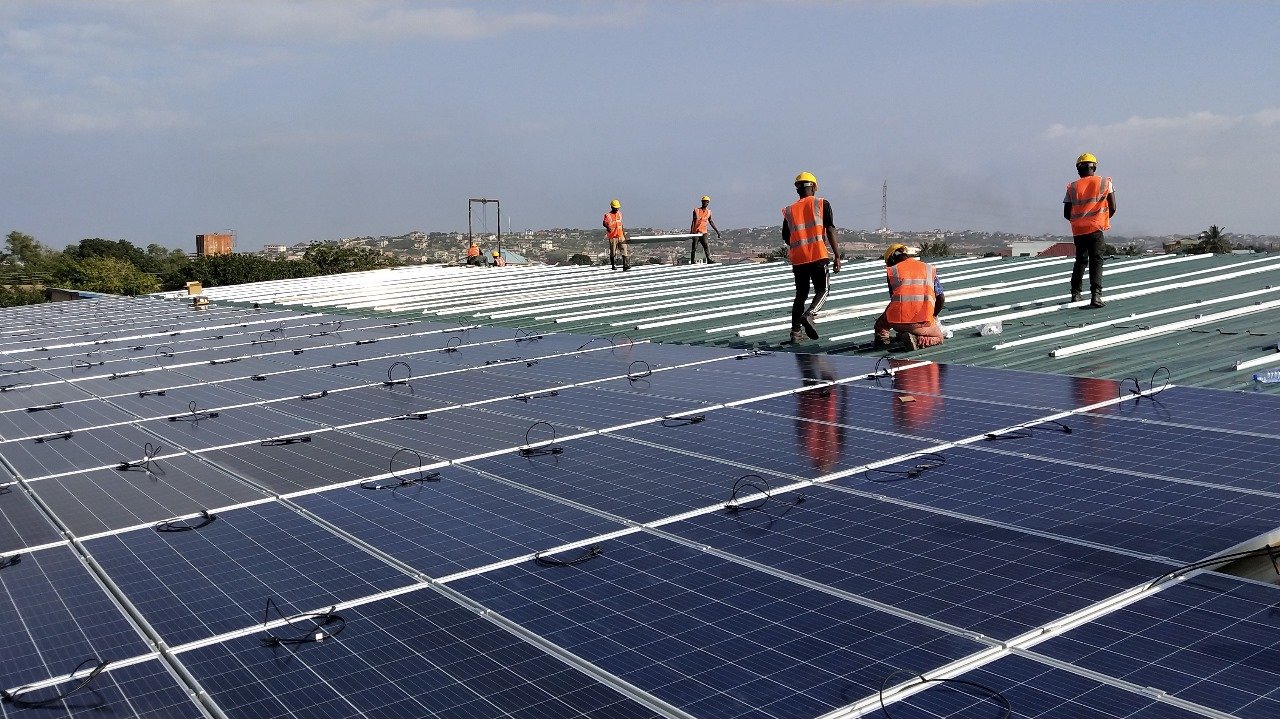Net metering is revolutionizing how businesses and industries in India manage their electricity costs. By connecting a solar PV system to the grid, excess solar energy generated can be exported, earning credits that offset electricity consumption from the grid. For industrial and commercial consumers, understanding the Net Metering ROI is essential to make informed investment decisions.
Table of Contents
What Is Net Metering?
Net metering is a billing mechanism that allows solar energy users to send excess power generated by their rooftop solar panels back to the utility grid and receive energy credits in return. These credits offset the electricity consumed from the grid, effectively lowering the user’s monthly bill. In India, net metering policies vary by state, but most encourage rooftop and captive solar projects, making it an attractive solution for cost-efficient energy management.
The net metering system typically involves the installation of a bidirectional meter that records both the electricity consumed from and sent back to the grid. At the end of the billing period, the utility company calculates the net difference between the energy consumed and exported, and the consumer is billed accordingly. This system benefits both consumers and the utility grid by promoting the use of renewable energy, reducing electricity costs, and enhancing grid stability.
For businesses, especially large manufacturing units, net metering can be a powerful way to cut electricity costs, maximize solar ROI, and optimize energy usage.
Key Features of Net Metering ROI
1. Substantial Electricity Cost Savings: Net metering allows businesses to offset their electricity consumption by exporting excess solar energy to the grid, leading to significant reductions in monthly electricity bills. This mechanism ensures that companies pay only for the net electricity consumed, effectively lowering energy costs.
2. Accelerated Return on Investment (ROI): The integration of net metering can lead to a faster payback period for solar investments. Businesses can recover their initial investment in approximately 3 to 5 years, depending on factors like energy consumption patterns and solar system efficiency.
3. Enhanced Grid Efficiency: By feeding surplus solar energy into the grid, businesses contribute to the overall efficiency and stability of the electricity distribution system. This decentralized energy production reduces the strain on the grid during peak demand periods.
4. Environmental Benefits: Utilizing solar energy through net metering reduces reliance on fossil fuels, leading to a decrease in greenhouse gas emissions. This transition supports corporate sustainability goals and enhances environmental stewardship.
5. Encouragement of Renewable Energy Adoption: Net metering policies incentivize the installation of solar panels by making them more economically attractive. This promotes the growth of renewable energy usage, supporting broader sustainability goals.
6. Flexible Credit Utilization: Excess energy credits earned through net metering can be utilized to offset future electricity consumption, providing businesses with flexibility in managing their energy costs. Home
7. Supportive Government Policies: The Indian government offers various incentives and subsidies to promote solar energy adoption, such as the PM Surya Ghar Muft Bijli Yojana, which provides financial assistance for residential solar installations.
Why Net Metering Is Crucial for ROI
1. Direct Reduction in Electricity Bills: Net metering ROI begins with significant savings on electricity bills. By exporting excess solar energy back to the grid, businesses and homeowners can offset their energy consumption. Many users report reductions of up to 90%, making net metering ROI an immediate financial benefit.
2. Accelerated Payback Period: A key component of net metering ROI is the faster recovery of your solar investment. Credits earned for surplus energy fed into the grid help reduce the payback period, typically ranging between 3 to 6 years depending on system size and local tariffs. This acceleration directly enhances net metering ROI.
3. Enhanced Return on Investment (ROI): Net metering ROI is maximized by turning excess solar generation into financial credits. Customers often experience an overall ROI of approximately 30% on their solar systems, demonstrating how net metering directly improves the financial viability of solar projects.
4. Increased Property Value: Solar installations with net metering not only save money but also boost property value. Incorporating net metering ROI into investment planning ensures that property owners gain both energy savings and long-term asset appreciation.

5. Support for Renewable Energy Adoption: Beyond individual savings, net metering ROI contributes to environmental benefits by encouraging the adoption of renewable energy sources. The financial attractiveness of solar power through net metering drives broader adoption, making it a sustainable investment choice.
6. Government Incentives: The Indian government supports solar adoption through various subsidies and incentives, such as the PM Surya Ghar Muft Bijli Yojana. These initiatives further enhance net metering ROI by reducing upfront costs and increasing the financial returns of solar systems.
What Does ROI Mean in Solar Projects?
In solar projects, ROI (Return on Investment) is the measure of how much financial benefit you gain compared to the money you invest in setting up a solar system. It’s one of the most important metrics decision-makers consider before going solar, as it directly shows the profitability and long-term value of the project.
How ROI Works in Solar
ROI in solar is calculated by comparing the total lifetime savings (from reduced electricity bills, incentives, and net metering credits) against the initial system cost (equipment, installation, and maintenance).
Formula

Factors Influencing Solar ROI
- Electricity Rates: Higher local electricity rates can lead to greater savings, thereby enhancing ROI.
- System Size and Efficiency: Larger and more efficient systems generate more electricity, increasing savings.
- Government Incentives: Subsidies and tax credits can reduce initial costs, improving ROI.
- Maintenance Costs: Lower maintenance costs contribute to higher net savings and ROI.
- Financing Options: The method of financing (e.g., loans, leases) affects the overall cost and, consequently, the ROI.
Maximizing Net Metering ROI in India
1. Optimize System Sizing
Proper system sizing is crucial for optimizing Net Metering ROI. A system tailored to match average energy consumption ensures sufficient electricity generation to meet needs while reducing excess power that may go unused. Oversizing results in higher upfront and maintenance costs, while undersizing risks not covering peak consumption, leading to reliance on costly grid electricity. To achieve optimal system design, conduct a comprehensive energy audit over 12 months to analyze daily and seasonal consumption patterns, thereby maximizing self-consumption and financial returns.
2. Align Energy Usage with Solar Generation
Effective energy usage patterns significantly influence return on investment (ROI) related to energy costs. By scheduling energy-intensive tasks such as operating air conditioners, washing machines, or industrial machinery during peak sunlight hours, one can utilize energy generated by solar panels. This approach enhances self-consumption, decreases dependency on grid electricity, and increases credits awarded for surplus energy sent back to the grid, thereby improving Net Metering ROI. To optimize this strategy, it is advisable to implement timers or smart energy management systems that align energy usage with solar energy production.
3. Invest in High-Quality Equipment
High-efficiency solar panels and reliable inverters play a vital role in ensuring consistent energy generation. Premium panels not only produce more electricity per square meter but also sustain their performance over decades. Inverters are essential for converting direct current (DC) to alternating current (AC) efficiently, which helps to minimize energy loss. Utilizing high-quality equipment leads to reduced downtime, lower maintenance costs, and less frequent replacements, all of which positively impact the Net Metering Return on Investment (ROI) throughout the lifespan of the system. It is advisable to select equipment that offers a robust warranty, typically 20 to 25 years for panels and 10 to 15 years for inverters, alongside verified performance certifications.
4. Leverage Government Incentives
India’s central and state governments offer various subsidies, tax benefits, and incentive schemes aimed at reducing initial capital expenditure and enhancing financial returns for projects like the PM Surya Ghar Muft Bijli Yojana. These incentives contribute to shorter payback periods and improved overall financial viability. It is advisable to stay informed about the latest policies in your state, as the benefits may vary based on the size and type of system (residential or commercial) and the date of installation.
5. Regular System Maintenance
Maintenance is essential for maintaining high solar panel performance. Factors such as dirt, debris, and shading can diminish efficiency, while loose connections or inverter problems may lead to energy losses. Conducting regular cleaning, inspections, and performance monitoring helps ensure optimal energy generation, thereby maximizing Net Metering return on investment (ROI). It is advisable to schedule panel cleaning every 3–6 months and implement monitoring software to promptly identify any declines in energy output.

6. Explore Virtual and Group Net Metering
Virtual and group net metering is advantageous for businesses, housing societies, and multi-property owners, as it enables different entities to collectively benefit from one solar installation. This approach optimizes energy distribution, lowers individual investment costs, and enhances overall financial returns. It is recommended to verify state regulations regarding virtual or group net metering and to design systems capable of servicing multiple facilities effectively.
7. Monitor Tariff Policies
Electricity tariffs and net metering regulations are subject to frequent changes. It is crucial to understand the workings of tariffs, feed-in rates, and credit settlement in your state to optimize energy consumption and export for financial gain. A recommended action is to subscribe to updates from your local Distribution Company (DISCOM) or energy regulatory authority, enabling timely adjustments to your energy strategy and maximizing the return on investment (ROI) from net metering.
8. Consider Energy Storage Solutions
Battery storage systems are designed to capture excess energy generated during sunny periods for later use, particularly during peak tariff times or periods without sunlight. This approach enhances self-consumption of energy, diminishes reliance on the grid, and provides opportunities for businesses to resell stored energy to the grid during high-rate periods, thus improving the return on investment (ROI) from Net Metering. To make an informed decision, it is advisable to assess battery options focusing on factors such as capacity, lifespan, and how well they integrate with existing solar systems.
9. Plan for System Expansion
As your energy needs increase, it’s important that your solar system is designed to scale efficiently without significant upgrades. Planning for future expansion allows for the addition of more panels or storage solutions as consumption rises, thus maintaining a high return on investment (ROI) throughout the system’s lifespan. To facilitate this, ensure to include space for extra panels in your initial design and opt for modular inverters that can accommodate future expansions with ease.
10. Educate and Involve Stakeholders
Engaging employees, tenants, or family members in energy-saving practices is essential for efficient solar energy usage. Behavioral changes such as turning off unused equipment, operating energy-intensive appliances during daylight, and monitoring energy consumption can greatly enhance system performance and increase Net Metering return on investment (ROI). To promote these practices, action tips include conducting awareness sessions, displaying real-time energy dashboards, and providing incentives for efficient energy use.
State-Wise Net Metering Policies and ROI Impact in India
1. Delhi
- The system size for net metering is up to 1 MW. The policy allows for the annual carryover of unused credits, creating a favorable financial environment. These credit policies and the carryover mechanism enhance net metering ROI, leading to quicker payback periods and improved financial returns for residential and commercial users.
2. Maharashtra
- Net metering covers system sizes ranging from 1 kW to 1 MW. Credit settlement follows a one-to-one billing model for any exported power, while transformer capacity is limited to 40%. This high export compensation directly boosts net metering ROI, increasing savings and overall returns on solar investments.
3. Uttar Pradesh
- Solar systems in UP can reach up to 2 MW, with credit settlement offered on both monthly and yearly bases. Subsidies under the PM Surya Ghar scheme, combined with flexible credit options, enhance net metering ROI by lowering upfront costs and maximizing long-term financial benefits.
4. Tamil Nadu
- Residential net metering allows users to generate up to 10 kW, reducing electricity expenses and improving net metering ROI. Commercial users, however, have shifted to a gross metering model, which affects ROI differently compared to residential setups.
5. Gujarat
- System sizes are capped at 1 MW, with an attractive tariff of ₹2.25 per unit for the first five years, followed by 75% of the market rate. These favorable tariffs significantly increase net metering ROI, making Gujarat one of the most financially rewarding states for solar energy investments.
6. Karnataka
- Karnataka allows net metering for systems up to 1 MW, with a residential tariff of ₹3.82 per unit for systems up to 10 kW. Yearly credit settlement and the upcoming introduction of virtual and group net metering from July 1, 2025, will further enhance net metering ROI, enabling consumers with multiple properties or shared installations to fully utilize solar credits.
7. Punjab
- System sizes range from 1 kW to 1 MW, with an annual carryover of up to 90% permitted. This high carryover limit ensures the effective utilization of surplus energy, consistently improving net metering ROI for users across residential and commercial sectors.
8. Haryana
- Haryana supports systems up to 2 MW, catering to domestic, industrial, and institutional consumers. The versatility in consumer categories promotes widespread solar adoption, significantly enhancing net metering ROI through substantial energy savings and long-term financial benefits.
9. Rajasthan
- System Size: Maximum capacity of 1 MW; Policy Type: Implemented net billing with specified caps; Tariff: Price range between ₹2.87 and ₹3.00 per unit; Impact on ROI: The net billing system featuring capped tariffs offers a balanced strategy, ensuring equitable compensation for systems while providing a consistent return on investment.
10. West Bengal
- System size is specified as up to 2 MW, with a tariff rate of ₹2.09 per unit. It is noted that limited implementation may negatively influence the overall return on investment (ROI).

ROI Calculations – With and Without Net Metering
| Parameter | Without Net Metering | With Net Metering |
|---|---|---|
| Total System Cost | ₹6,00,000 | ₹6,00,000 |
| Annual Benefit | ₹80,000 | ₹98,000 |
| Lifetime Savings (25 yrs) | ₹20,00,000 | ₹24,50,000 |
| ROI | 233% | 308% |
| Payback Period | 7.5 years | 6.1 years |
Beyond Financial ROI – Hidden Benefits of Net Metering
1. Environmental Impact
Net metering encourages the use of solar energy, a clean and renewable resource. By reducing reliance on fossil fuels, it helps lower greenhouse gas emissions and mitigates air pollution, contributing to a healthier environment.
2. Grid Stability and Support
Excess solar energy fed back into the grid through net metering can alleviate pressure during peak demand periods. This decentralized energy production enhances grid reliability and supports the integration of renewable energy sources.
3. Increased Property Value
Homes equipped with solar energy systems and net metering capabilities are often viewed as more attractive to potential buyers. These properties may command higher resale values due to their energy efficiency and lower operating costs.
4. Community and Societal Benefits
By participating in net metering, individuals contribute to a collective effort in reducing the carbon footprint. This shared responsibility fosters a sense of community and supports broader sustainability goals.
5. Energy Independence
Net metering allows consumers to generate their own electricity, reducing dependence on utility providers. This autonomy can be particularly beneficial in areas with unreliable power supply or frequent outages.
6. Educational Opportunities
The implementation of net metering systems provides opportunities for education and awareness about renewable energy technologies. It encourages individuals and communities to learn more about sustainable practices and energy conservation.
Challenges in Net Metering ROI
1. Regulatory Inconsistencies Across States
India’s federal structure results in varying net metering policies across states. For instance, some states have implemented caps on system sizes eligible for net metering, while others have introduced gross metering systems for larger capacities. Such discrepancies create confusion among consumers and developers, affecting the scalability and financial viability of solar projects.
2. Infrastructure Limitations
Many regions in India lack the necessary grid infrastructure to support bi-directional energy flow. This inadequacy can lead to issues like voltage fluctuations and grid instability, which may result in the rejection of solar net metering applications or curtailment of generated solar power.
3. Delays in Implementation and Approvals
The process of obtaining approvals for net metering connections can be lengthy and cumbersome. For example, Nagpur Metro’s 1.5 MW solar project faced significant delays due to the Maharashtra State Electricity Distribution Company Ltd’s (MSEDCL) failure to update its portal to accommodate higher-capacity solar applications. Such delays can lead to financial losses and missed opportunities for consumers.

4. Financial Implications for Distribution Companies (DISCOMs)
While net metering benefits consumers, it can pose financial challenges for DISCOMs. The reduced revenue from consumers who generate their own electricity may affect the DISCOMs’ ability to maintain and upgrade infrastructure, potentially leading to increased electricity rates for non-solar consumers.
5. Quality Assurance and Consumer Awareness
The rooftop solar market in India faces challenges related to the quality of installations and lack of consumer awareness. Many consumers are unaware of the technical and financial aspects of solar systems, leading to suboptimal installations and lower-than-expected ROI.
Future of Net Metering ROI in India
The future of net metering ROI in India looks highly promising, driven by a combination of policy reforms, technological advancements, and market growth. In 2025, efforts to standardize net metering policies across states are reducing regulatory uncertainties, simplifying approvals, and encouraging broader adoption of rooftop solar systems. The integration of energy storage solutions, such as batteries, allows consumers to store excess solar energy for use during peak hours or at night, maximizing financial benefits and further improving ROI. Additionally, the emergence of virtual and group net metering models enables multiple consumers, including housing societies and commercial complexes, to share the benefits of a single solar installation, reducing individual costs and enhancing returns.
Declining costs of solar panels and related equipment, along with government incentives such as the PM Surya Ghar Muft Bijli Yojana, are lowering initial capital expenditure, shortening payback periods, and increasing long-term savings. Coupled with the expected rapid growth of the rooftop solar market—projected to reach 41.52 GW by 2030—these developments indicate that net metering will deliver higher financial returns, faster payback periods, and a more sustainable energy future for both residential and commercial consumers in India.
Net Metering ROI – A Game-Changer for Businesses
For businesses in India, rising energy costs and sustainability targets make Net Metering ROI more important than ever. By generating their own solar power and exporting surplus energy to the grid, companies can turn excess energy into financial credits, directly lowering electricity bills and enhancing Net Metering ROI. This not only shortens the payback period of solar investments but also maximizes overall returns.
Beyond the financial advantages, net metering provides businesses with energy independence, reducing reliance on the grid and exposure to power outages or fluctuating tariffs. It also strengthens corporate sustainability initiatives by cutting carbon emissions and improving green credentials—factors that enhance brand reputation and appeal to eco-conscious clients and investors.
Furthermore, businesses can leverage group and virtual net metering to optimize energy usage across multiple facilities, ensuring efficient solar deployment and further boosting Net Metering ROI. Combined with government incentives and declining solar installation costs, net metering transforms rooftop solar from a simple cost-saving tool into a strategic business decision that delivers long-term financial and environmental benefits.
Conclusion
Net metering is a powerful tool that transforms solar energy from a simple cost-saving measure into a high-impact investment. By allowing businesses and homeowners to generate their own power and earn credits for surplus energy fed into the grid, net metering significantly enhances ROI, shortens payback periods, and promotes long-term financial and environmental benefits. Beyond monetary returns, it supports energy independence, reduces carbon footprints, and strengthens sustainability credentials—making it a strategic choice for any forward-thinking energy consumer.
Explore how implementing a rooftop solar system with net metering can transform your business. Contact our solar experts at Soleos Energy to assess your energy needs, calculate potential savings, and unlock the full financial and environmental benefits of net metering. Don’t just save energy—turn it into a strategic advantage for your business.
